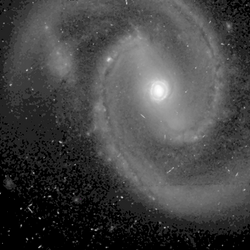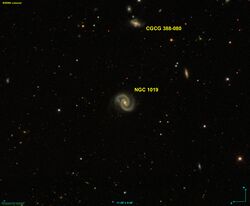Astronomy:NGC 1019
From HandWiki
Short description: Galaxy in the constellation Cetus
| NGC 1019 | |
|---|---|
 NGC 1019 (NASA/ESA HST) | |
| Observation data (J2000.0 epoch) | |
| Constellation | Cetus |
| Right ascension | 02h 38m 27.41s[1] |
| Declination | +01° 54′ 27.79″[1] |
| Redshift | 0.024340[1] |
| Helio radial velocity | 7297 ± 20 km/s[1] |
| Distance | 316 Mly[2] |
| Apparent magnitude (V) | 13.60[3] |
| Apparent magnitude (B) | 14.40[3] |
| Characteristics | |
| Type | SB(rs)bc[1] |
| Apparent size (V) | 1.0 × 0.9[1] |
NGC 1019 is a barred spiral galaxy approximately 316 million light-years away from Earth in the constellation of Cetus.[2] It was discovered by French astronomer Édouard Stephan on December 1, 1880 with the 31" reflecting telescope at the Marseille Observatory.[4]
NGC 1019 is classified as Type I Seyfert galaxy.[2] Its nuclei is surrounded by tight rings or annuli of star formation,[5] and the rings contain compact, young star clusters.[6]

NGC 1019 (SDSS)
See also
References
- ↑ 1.0 1.1 1.2 1.3 1.4 1.5 "NASA/IPAC Extragalactic Database". http://ned.ipac.caltech.edu/cgi-bin/objsearch?objname=NGC+1019.
- ↑ 2.0 2.1 2.2 Xanthopoulos, E. (1996). "VRI CCD surface photometry of Seyfert 1, Seyfert 2 and intermediate Seyfert-type galaxies". Monthly Notices of the Royal Astronomical Society 280 (1): 6–28. doi:10.1093/mnras/280.1.6. Bibcode: 1996MNRAS.280....6X.
- ↑ 3.0 3.1 "Revised NGC Data for NGC 1019". http://spider.seds.org/ngc/revngcic.cgi?NGC1019.
- ↑ "Data for NGC 1019". http://www.astronomy-mall.com/Adventures.In.Deep.Space/NGC%201000%20-%201999%20(11-30-17).htm.
- ↑ "Closeup views of Seyfert nuclei from HST". http://pages.astronomy.ua.edu/keel/agn/synuclei.html.
- ↑ "Star clusters in circumnuclear rings". https://ned.ipac.caltech.edu/level5/LHo2/Ho4.html.
External links
- NGC 1019 on WikiSky: DSS2, SDSS, GALEX, IRAS, Hydrogen α, X-Ray, Astrophoto, Sky Map, Articles and images
- SEDS
 |

